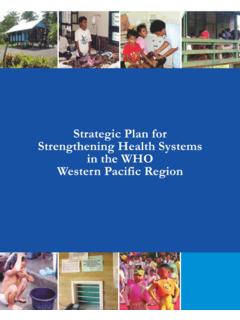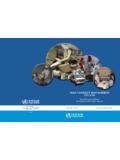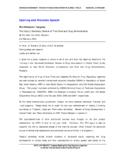Transcription of The Role of SHG in Women Empowerment- A Critical Review
1 IOSR Journal of Economics and Finance (IOSR-JEF) e-ISSN: 2321-5933, p-ISSN: 7, Issue 3. Ver. II (May. - Jun. 2016), PP 33-39 DOI: 33 | Page The Role of SHG in Women Empowerment- A Critical Review R. Vishnuvarthini and Ayyothi* PG and Research Department of Economics, Government Arts College, Tiruvannamalai -6060603, Tamilnadu, India. Abstract: Women empowerment is the important factor for the uniform growth of a nation. On this aspect the self help group plays a major role in deciding the Women empowerment in the rural areas. SHG promotes the socioeconomic strength to the weaker section of the community and thereby promoting the uniform growth of the nation. This Review article gives a complete picture of the success of SHG towards Women empowerment. Almost all the study finds that the SHG members gain equality of status, Women as participants, and decision makers in democratic, economic and social spheres of life.
2 This article also, throws some of the measures to be taken for the effective implementation of SHG. I. Introduction International level Sambat (1988)1 et al studied in his paper regarding the SHGs in Thailand. And he observed that SHGs, in addition to their normal savings and lending activities, diversified their production activities. The study concludes that SHGs will be viable when they diversify in their activities. In 1984, the Federal Ministry of Economic Cooperation and the Agency for Technical Co-operation in the Federal Republic of Germany undertook a series of studies resulting in a new policy for promoting Self Help Groups (SHGs), which is different from the Grameen Bank model proposed by the Kropp in his paper (Kropp 1989)2. The first SHG was started way back from 1986 by the members of Asia Pacific Rural and Agricultural Credit Association (APRACA) in the workshop held in China in 1986 which is proposed by Ramanathan (1993)3.
3 Sixth general assembly of APRACA held in Nepal which is decided to launch the SHG linkage program. In Srilanka, some of the operating SHGs emerged voluntarily and others took birth due to Self Help Promotional Institutions. While in the former, members belong to different income groups, in the latter membership was given to specific target groups. Some SHGs supplemented the common fund with the seed money or contributions from self help promoting institutions (SHPIs). Up to 1993, the rate of loan recovery was around 90 percent in Sri Lanka. Further, He concluded that on the whole, the performance of SHGs was fairly well compared to other borrowers of the formal banking system. In 1988, Indonesia started a project entitled Linking Banks and SHGs as a pilot project operated by the Central Bank of Indonesia through the involvement of Self Help Promotional Institutions (SHPI). The main aim of that project is to provide training and consultancy services to the SHGs and in some cases, they also act as Financial Intermediaries (Koch and Soetjipto (1993)4.)
4 In Bangladesh the Grameen bank was stated in 1983 by the Prof. Mohemmed Yunus and he observed that the role of micro credit is facilitating Women s potential (Khandker and others (1995)5. The linkage banking concept is observed while studying SHGs in the nations like Indonesia, Thailand, Philippines, India, Nepal and Bangladesh (Noor (1995)6. Noor observed that the seeds of linkage banking were sown in 1986 and today SHGs are widely accepted as an alternative for collective credit delivery to the poor. The valuable lessons learned by the Asian groups SHG is listed by Kropp (1997)7. In his concludes, he frankly admitted that the survival of the SHG is in the hands of multilateral and bilateral donors. National level Development of Women and Children in Rural Areas (DWCRA) was studied by two different groups. Ghosh (1995)8 in his study he concludes that group cohesiveness is the primary factor in the success of DWCRA.))
5 Also, Yerram Raju and Firdausi (1995)9 made an extensive study on the effect of measurable variables of the function of DWCRA. An extensive and detailed report is published by the National Bank for Agriculture and Rural Development (NABARD) in the year199810. In that report several features of SHG s are revealed, namely, the efficient flow of credit, utilisation of credit for the income generating activities, loan repayment and improved empowerment. A bold statement was made by Shakuntala Narasimhan (1999)11, saying that the even after five decades of economic planning, the status of the Women is not changing much in India. He concludes that the mind set of the people is the key factor for the Women empowerment in India. The advantages/success of the SHG in the rural banking sector is thoroughly investigated by the Karmakar (1999)12. Conventional rural banking is severely hampered by several factors like, poor loan recovery performance, weak human resource, etc.
6 In order to overcome these factors, SHG s is tied up with various NGOs and banks. This leads to the SHGs is emerging as a viable credit mechanism in the rural areas with excellent Women The Role of SHG in Women Empowerment- A Critical Review DOI: 34 | Page empowerment. Also, in his studies, he suggested various suggestions to minimise the flaws in the traditional rural banking system. The effect of SHG in the slum area of Chennai is investigated by Vijayanthi (2000)13 in the year 2000 and according to that report, the Women empowerment is attained through SHG s in slum areas of Chennai. Similarly, work is performed by the Laxmi R. Kulshreshta and Archana Gupta (2001)14 and they discussed the problem faced by the traditional banking in the rural areas. According to them, the quick transformation to self reliance through social mobilization and awareness creation among the poor people is the most cost effective strategy which is available in the SHG strategy.
7 In the year 2001, NABARD (NABARD (2001)15 comes up with a strategy in the field of Women Empowerment. According to the report, the utmost importance should be given for transformation of micro groups to Small/Medium Enterprises through strengthening credit delivery to Women s groups which will lead to the Women empowerment in the rural areas. The role of government, along with the international efforts to link formal and informal system of lending was investigated by Dasgupta (2001)16 in the year 2001. The study concluded that the autonomy in the decision making toward tying up with the SCHG should be given to the NGO and banks. SHG in the Andhra Pradesh was reviewed by the Datta and Raman in the year 200117. The study concludes that the success of SHGs in terms of high repayment in the study area is mostly related to the exploitation of the prevailing social ties and social cohesion found among Women members.)
8 The strength and the weakness of the SHG is pointed out in the year 2001 by Namboodri and Shiyani (2001)18. In his study, he pointed out seven advantages and two weaknesses of the existing SHG systems. The advantages of Oriental Grameena Project in India are pointed out by the Dadhich (2001)19 and he concluded that if properly designed and effectively implemented, microfinance can be a means not only to alleviate poverty but also to empower the Women . The role of SHG in empowering Women in the state of Maharashtra is reviewed by the Madheswaran and Dharmadhikary (2001)20. The most part of the study supported the theory of peer monitoring system. The urgent need for the people to understand and solve their problem on their own is emphasised in the report submitted by the National Institute of Rural Development (NIRD) (2003)21. The study concluded that the SHG members had better health care, better education, and elimination of child labour, better courage and confidence.
9 A detailed report regarding income generation, human development, environmental protection and natural resources management through SHG is presented by the Krishnaiah (2003)22. He concluded that the success of SHG is depends on the identification of proper products for manufacturing, use of appropriate technology and creating necessary marketing channels. The new dimension to the SHG is provided by the Tripathy (2004)23 towards the function of the SHG vital role of SHGs in rural development by saying that SHGs are instruments for social mobilization, economic empowerment, capacity and entrepreneurship building, and community solidarity. The author explains that while aiming at promotion of savings and credit, should work as pressure groups to address social issues such as education, health, lack of access to natural resources etc. The advantage of SHG over conventional banking system towards reaching poor peoples is explained by the Nanda (2004)24.
10 Similarly, role of government organisations like NABARD along with the SHG towards eradicating poverty in India is reviewed by the Shylendra (2004)25. The author pointed out the failure of government machineries and suggested for measures like widening and deepening of the SHG base, protecting the credibility of SHGs, updating the members' skills in order to retain the basic features and strengths of SHGs. Alka srivastava (2005)26 did extensive study of SHG s groups in four Indian states namely Bihar, Chhattisgarh, Madhya Pradesh and Uttarpradesh. According to him, the bonded labour problems, Dalit rights and domestic violence had been reduced due to Women s empowerment through SHG s. A famous quotation "the empowerment of Women covers both an individual and collective transformation." Is given by the Kulandaivel (2005)27. The Study reveals that the SHG is facilitating income generating activities for socio economic upliftment and also promoting qualitative aspects like group dynamics, collective action and awareness generation.

















